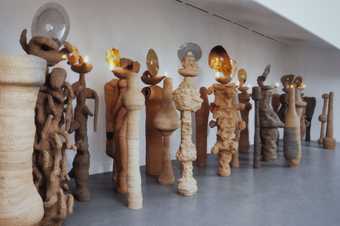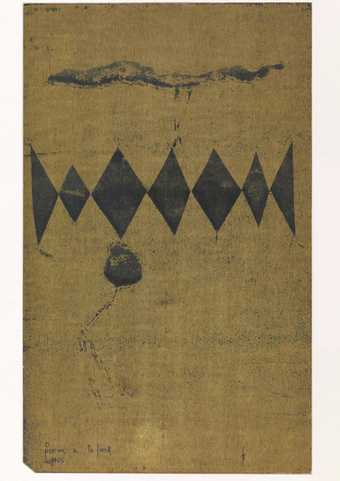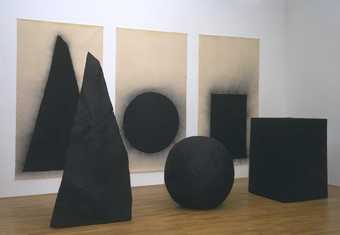An installation comprising thirty-three figures in terracotta, metal, wick, paraffin and flame. Twelve figures representing the Apostles surrounded by a multitude of twenty-one. Installation at the Tate Gallery measures 12.5 x 3 metres.
The Apostles Speaking in Tongues
On the Jewish feast of the Pentecost, the Holy Spirit was said to have come upon the Apostles in Jerusalem enabling them to speak in tongues to those present. The language of this text in the Authorised Version is richly atmospheric. The Holy Spirit descends amidst a ‘rushing mighty wind’ and appears in the form of ‘cloven tongues of fire’. Nicholas Pope’s Apostles are likewise the bearers of fire. Made in brick clay of variegated earth-colours, each figure supports a primitive oil-lamp backed by a halo in beaten metal. The lamps provide a pulsating glow which is reflected from the polished metal and is also thrown, like stigmata, through the haloes’ circular apertures. In the flickering half-light the Apostles cast their aura upon a host of ceramic figures.
Nicholas Pope’s vision of the Pentecost is part of an ambitious project, initiated in 1992-3, to create a non- denominational chapel, the Oratory of Heavenly Space. Pope has completed a monumental polychrome reredos (a device to screen the area behind the Altar) on the theme of Yahweh and the Seraphim; a series of ceramic fonts; and a maquette of the building itself. Pope’s chapel, with its network of tunnels and chambers, will be a place of mystery rather than of doctrine, a space for contemplation, speculation and maybe revelation. Illuminated by the lamps of the Apostles, the multitude of lesser figures peopling its spaces will ensure that no one entering it should feel alone.
During the 1970s Pope, together with Barry Flanagan and David Nash, had become well known as an artist operating on the margins between organic and conceptual sculpture. His work was characterised by an interest in the physical aspects of materials and modes of construction, his sculptures often made from an accumulation of similar parts and emphasising the process of making itself. The Oratory of Heavenly Space marked a radical change in direction: it developed as part of a slowly evolving process of rehabilitation following years of serious illness. Pope had contracted a number of rare encephalitic viruses on a visit to Africa in 1982, which went undiagnosed for several years and left the artist with a degree of permanent brain damage and a severely impaired working life. In brief moments of therapeutic activity Pope began working again, in clay, and it was in small and hesitant pieces of coloured porcelain that he first worked on the ideas behind the Oratory. While demonstrably related to his earlier work, the intellectual concerns of this project lie outside the customary domain of contemporary art.
Pope’s ill-fated journey to Africa was inspired by an interest in Makonde sculpture, and the Makonde practice of depicting dreams in images which are both abstract and symbolic. The symbolism of Pope’s Apostles is drawn from the Bible and came through thinking about what each Apostle might have been like. Just like the individuals who make up the average Anglican community -the clergy, the parish council, the parishioners -the twelve apostles came from ordinary walks of life, from agriculture, teaching, the world of commerce. Like members of a congregation, some were good and trusting souls, others turned out to be less wholesome. A few, like Thomas or Judas, played distinctive and memorable parts; others, like Andrew, the spear-carrier, seem to have hovered on the sidelines of the drama and remain indistinct. Pope doesn’t take a neutral view of the twelve. His figures are breathtaking and imposing but at the same time they include aspects of the hideous and the comical. Each figure is identified by his attributes: Doubting Thomas sports trunk-like bloodsucking appendages; Matthew, a tax-collector, carries a heavy paunch while the two-faced Judas has fleshy protruding lips.
The Apostles found their form slowly. Behind their idiosyncrasies of character they are made according to an identical physical process. Still prevented by the effects of illness from working for extended periods of time, Pope works in stages, methodically building up his figures in measured periods of activity, progress registering in a linear rhythm of thumbprints that structure and animate the surfaces of the work. In between periods of work Pope rests under self-hypnosis.
Before withdrawing from the art world in the mid-1980s Pope had already shifted ground in his work as he began to introduce human associations through scale and shape, and employed traditional skills, such as wood carving, as means of fabrication. The human associations of the Apostles and the multitude are very strong, not just in their scale, but also in the evidence of their making by means of a very basic manual skill and the fact that they are in themselves merely hollow vessels, containers of the simplest kind.
The mysteries of Revelation and Salvation and the nature of faith are bound up in the story of the Pentecost just as they are in Pope’s investigation of it. But before any iconographical or liturgical reading of this work, available to those with a grasp of the New Testament, it reveals itself as a powerful physical and atmospheric presence. To Pope, who has pulled himself back from the brink of despair, faith is less about doctrine than about passion, about living in the world and experiencing it emotionally as well as physically. The relationship between the physical and the emotional, between the spatial and the spiritual is now crucial to Pope’s undertaking: this is so not only in his working process, where intellect and spirit are engaged through manual activity, but also in the installation of the work, where the visitor may encounter a spiritual dimension through a simple experience of an intensely sensual environment animated by objects loaded with symbolic references.
Text written by Frances Morris

Nicholas Pope, The Apostles Speaking in Tongues 1996 © Tate Photography
THE ACTS, 2
1 And when the day of Pentecost was fully come, they were all with one accord in one place.
2 And suddenly there came a sound from heaven as of a rushing mighty wind, and it filled all the house where they were sitting.
3 And there appeared unto them cloven tongues like as of fire, and it sat upon each of them.
4 And they were all filled with the Holy Ghost, and began to speak with other tongues, as the Spirit gave them utterance.
5 And there were dwelling at Jerusalem Jews, devout men, out of every nation under heaven.
6 Now when this was noised abroad, the multitude came together, and were confound- ed, because that every man heard them speak in his own language.
7 And they were all amazed and marvelled, saying one to another, Behold, are not all these which speak Galilreans?
8 And how hear we every man in our own tongue, wherein we were born?
9 Parthians, and Medes, and Elamites, and the dwellers, in Mesopotamia, and in Judrea, and Cappadocia, in Pontus, and Asia,
10 Phrygia, and Pamphylia, in Egypt, and in the parts of Libya about Cyrene, and strangers of Rome, Jews and proselytes,
11 Cretes and Arabians, we do hear them speak in our tongues the wonderful work of God.
12 And they were all amazed, and were in doubt, saying one to another, What meaneth this?
13 Others mocking said, These men are full of new wine.
14 But Peter, standing up with the eleven, lifted up his voice, and said unto them, Ye men of Judrea, and all ye that dwell at Jerusalem, be this known unto you, and hearken to my words: 15 For these are not drunken, as ye suppose, seeing it is but the third hour of the day.
16 But this is that which was spoken by the prophet Joel;
17 And it shall come to pass in the last days, saith God, I will pour out of my spirit upon all flesh: and your sons and your daughters shall prophesy, and your young men shall see visions, and your old men shall dream dreams.
- The Acts of the Apostles, Chapter 2, v.1-17, The Holy Bible, Authorised King James Version.
Biography
Born 1949. Trained at Bath Academy of Art 1970-73. Lives and works in Herefordshire.
Programme
The 1996-7 exhibition programme is supported by the Henry Moore Foundation, the Patrons of New Art and an anonymous donor.





